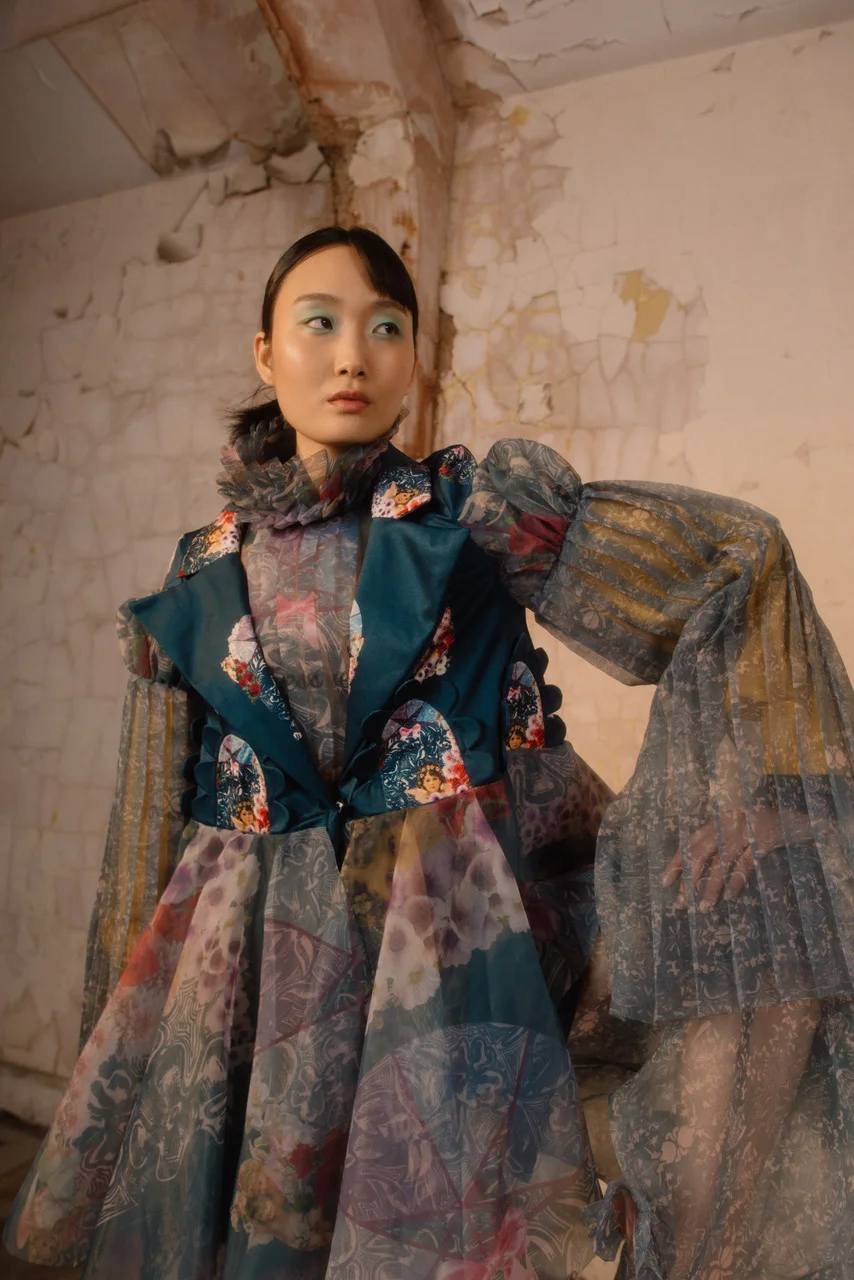We’ve been teasing the GFW19 campaign release for weeks, and we’re finally ready to share the final product! Shot by photographer Erika Astrid and styled by Jennifer Mertens, the campaign featured the work of students from across the UK.
The students’ designs who were selected to debut in the photoshoot showed a range of diverse influences and unique styles. Some focusing heavily on ethically sourced materials, using sustainable methods and recycled pieces to create eco-conscious designs. Others focused on unique methods of design, such as laser-etched wood detailing.
A highlight of this year’s campaign has been the inclusion of final year students in the photoshoot — from shooting behind the scenes videos, to assisting with hair and makeup, and styling. The final year students involved on the day relished the opportunity to network and build their portfolios.
Check out the full campaign, meet the students behind the garments and watch our behind the scenes video by students Katie Richardson and Llinos Peters below.
Charley Parr: University of Central Lancashire
Sustainability is a huge factor for Charley, as her designs were driven by her passion for using preowned materials that would be otherwise headed for landfill. Her red ombre knitted two-piece with pendant embellishments was comprised largely of donated knitwear that she acquired through friends, family, charity shops and the company she worked at for placement year.
Recycled cones of yarns that had been abandoned at her University, and ‘imperfect’ tights that were otherwise headed for landfill were also kindly donated from the brand ‘UK Tights’. The concept behind Charley’s design was based around the “imperfections” of a women’s body and the “lumps and bumps” that usually get airbrushed or hidden. The prominent pendant embellishments instead draw a strong focus to these “lumps and bumps” and help to create a unique silhouette.
Jogaile Zairyte: University of Portsmouth (left image)
Lithuanian born Jogaile gave up a life of finance and banking to live out her creative dreams in fashion. Her sustainable collection is inspired by Japanese culture and beliefs, embracing different hand-crafted techniques and natural hand-dyeing methods. All materials used were natural and organic such as hemp, cotton, peace silk, linen, bamboo and they were hand-dyed using natural dyes such as avocado stones, turmeric and indigo.
Inspired by Japanese culture, Jogaile used the sashiko technique to create different textile designs. To minimise all waste, she created an efficient zero-waste pattern cutting technique comprising of rectangular, square and triangle shapes. These shapes were then joined together using a crocheting method.
Margaret Sam: Kingston University
Being of Chinese diaspora, where Chinese people make up 0.7% of Britain (ONS, 2011), the complexities of cultural identity continue to be integral to Margaret’s practice. The duality of her heritage, being British-Chinese and living within multiculturalism has set the foundation for her final collection titled; Where Are You From? This design, like the whole of Margaret’s collection is about using personal experiences to revise and push our notions of cultural identity, encouraging cultural collaboration, and celebrating our similar and different heritage as a cosmopolitan society.
The print in the outerwear abstracts Korean Hangul and is a play on the word “foreign”. Margaret chose this word because its meaning felt integral to the complexities of cultural identity; that and the multi-layered question “where are you from?” As WW1 and WW2 are integral to British world history, and particularly to Churchill’s construction of British Identity, military references are heavily integrated. Traditional waxed cotton from a British mill (to also reduce transport pollution and promote local production) has been used as garment reinforcement to give the garment a longer life. The nylon ripstop has been utilised for its recyclable properties and also durability to promote slow fashion.
Carline Zhou: University of Salford
Carline’s inspiration for her collection was Endless Love. For this outfit, the concept was a modern dream wedding, with stained glass windows as the primary inspiration for the design. She says girls are expected to think about falling in love at a young age, but they do not want marriage to hinder their life dreams. Women don’t need to have a fairy-tale ending with a prince, they should be queen of their own world and enjoy a life of freedom, nature, and friends.
Carline’s designs show a powerful, sweet and romantic feeling. She often uses print in her design because her father was a print and textile designer, who has profoundly influenced her. She also likes to use recreation of textile, colour matching, and other methods to design her garments. Carline loves to try new things and draw inspiration from two opposing things or stories for a big impact.
Agnese Balsamini: Academia Costume & Moda (Left image)
Born in picturesque Rome, Agnese was first transfixed and inspired by the fashion world on a family trip to Paris. Her voluminous and transparent designs took inspiration from the Icelandic singer Bjork along with the designs and vibes given by Kengo Kuma’s architecture. The monochromatic pink outfit, which consists of two garments: a voluminous blouse with big sleeves and a see-through skirt, is part of Agnese’s “Náttúra” capsule collection. “Náttúra” takes its name from one of Bjork’s famous songs and her garments are made by bypassing the “traditional” canons of female beauty, preferring a world of exploration of volume and geometry. To achieve the perfect transparency, different weights of Organza were manipulated to produce the perfect volume.
Brian Mc Lysaght: Edinburgh College of Art
Irish born Brian was inspired by the role of clothing in 20th Century decolonisation movements, particularly the Swadeshi movement in India, when creating his spectacular wooden designs. To protest India’s exploitation under colonial powers, ritualised burnings of Western clothing were performed, and instead indigenous Indian fashions were adopted as a mode of resistance. Similarly, Brian’s designs aim to decolonise Irish fashion through the revival and reconstruction of the ancient visual languages that existed in Ireland prior to their erasure under British colonialism.
Inspired by the material culture of early Irish civilisations, Brian relied on locally available organic materials such as wood, leather and bone. The turtleneck is entirely wooden with an interlocking construction, featuring patterns inspired by stone carvings or Neolithic tombs found across Ireland. The wooden trousers were stained with inks in an ombre effect and laser etched with hand-drawn patterns inspired by illustrations from ancient Irish manuscripts. The entirely wooden garments are sustainable and biodegradable, whilst also looking like artefacts from a primeval society.
Lisa Gerstendfeld: Cambridge School of Visual and Performing Arts
Lisa, born in Indonesia, was inspired by psychedelic mushrooms in the design process of her garments. She was fascinated by the role that mushrooms play in maintaining large ecosystems on our planet, acting as a communication network between different species of plant life. But what was most significant for Lisa was the effect that psychedelics have on the human brain, inducing states of interconnectivity, creative openness, and a capacity to overcome mental health problems such as anxiety and depression.
The shape and the texture of different types of mushrooms can be seen subtly in this design. This design also references aspects of the 1960’s Psychedelia subculture, including the rich and colourful clothing of Jimi Hendrix. The prints and embellishment are partly inspired by Psychedelia posters from the 60s, flower power counter culture, and the visual effects of psychedelics.
Alexandra Fan: Edinburgh College of Art
Alexandra Fan, born in China, was inspired by the coexisting rhythm and chaos of the urban village Guizhou, her hometown. She also got inspiration from the idea of the individual life trajectory and collected people’s footprints, which were developed into a part of the 3D texture on her material. She also got some ideas from flight suits in early 20s. This combined with the brutalist architecture became the silhouette of the garment. The garments were made in food grade silicone. The material was casted in the moulds and all the 3D textures with different depth were formed in one go.












